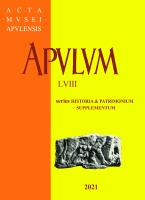Din sursele grafice ale miniaturistului Picu Pătruț
Graphic Sources of Miniature Painter Picu Pătruţ
Author(s): Cornel Tatai-Baltă, Anca Elisabeta TataySubject(s): History, Cultural history, Modern Age, 19th Century
Published by: Muzeul National al Unirii Alba Iulia
Keywords: Picu Pătruţ; Sălişte; miniature; woodcut; metal engraving; Buda; Braşov; Sibiu; Bucharest; Târgovişte;
Summary/Abstract: Picu Pătruţ was born at Sălişte, a shepherd village in Mărginimea Sibiului, in 1818. He learned reading and writing in his native village, became a sexton, then turned a monk and for a while taught in school. In 1872, he died at the age of 54.He was a pious person, evincing an uncommon thirst for religious knowledge but also for secular culture of good quality. His library comprised 200 titles: both religious books and Romanian and foreign literature, in translation.Picu Pătruţ left the generations to come numerous manuscripts, a part of them being lost. His work that includes religious plays, pieces of poetry, miniatures and melodies, is surprisingly vast and varied. He is supposed to have accomplished about 3000 miniatures, of which 2000 have been conserved until the present time.The most important manuscript, from a poetic and artistic point of view, achieved between 1842 and 1851, entitled Stihos, namely Verse, is kept in the National Museum of the Romanian Peasant. It sums up 1400 pages, 474 verses, 579 miniatures and 128 vignettes. The creations of the ”peasant” artist are ”naive but deep in the same time” being characterized by piety, naturalness and sincerity. Picu Pătruţ is said to have decorated his manuscripts, wavering between dogmas and the liberty to create. As the artist was familiar with the Orthodox iconography, he had knowledge of the mural painting, icons on glass and wood as well as of the illustrations in the printed books. The means of expression used to elaborate his compositions are simple but suggestive and their chromatics is delicate and limited. It’s no doubt that the woodcuts or metal engravings that adorn the Romanian religious books printed in different typographic centers: Buda, Braşov, Sibiu, Târgovişte, Bucharest, etc. were Picu Pătruţ’s sources of inspiration. As in many other situations (for example in the manuscript The Death of Abel, 1843), the gifted artist from Sălişte, considered to be „the last miniaturist of Europe”, retorted to changes, resigned certain elements, included others and harmonized chromatics in accordance with the chosen subject.
Journal: Apulum
- Issue Year: 58/2021
- Issue No: 1 Supp.
- Page Range: 175-198
- Page Count: 24
- Language: Romanian
- Content File-PDF

